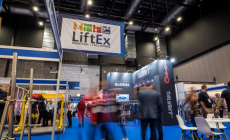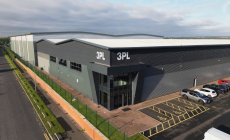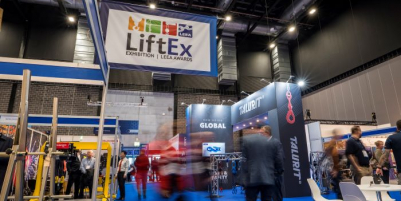-
Women Leading the Way in the UK Material Handling Industry - December 12, 2025
-
LiftEx 2025 live from Liverpool - December 11, 2025
-
DATA ANALYSIS – THE FOUNDATION OF EVERY PEAK SEASON - December 5, 2025
-
Creative education specialists Creative Hut give 3PL full marks for onboarding excellence - December 5, 2025
-
Unlimited Industries raises $12M to build the AI construction company that will power America’s future - December 4, 2025
-
Scottish Leather Group gets full-support solution from Rushlift - December 4, 2025
-
Etaily lands strategic investment from Japan’s SMBC – bringing total funding to $24M for Social Commerce enablement platform - December 4, 2025
-
Winners lift their LEEA Awards and raise the industry - December 4, 2025
-
Prism eLogistics and Brand Angels Partnership Gives Brands the Full Package - December 3, 2025
-
New data shows Tesla in danger of losing its way as European consideration to buy Chinese cars jumps 16% in 12 months - December 3, 2025
Warehouses, transport hubs and fulfilment centres will be under immense pressure to perform in 2026. But what are the key trends and influences driving change? Craig Davenport, Sales Director at Rushlift sets the scene.
1. Safety first: Going beyond compliance
Safety will remain the top priority for businesses operating material handling equipment in 2026. According to the British Safety Council around 1,300 people a year are involved in forklift related accidents. Several are fatal. Failure to maintain a safe working environment can have dire legal consequences for a business and its directors, so getting the best value from a truck in terms of safety is now widely seen as absolutely essential.
Ensuring that trucks are correctly specified for the task and equipped with critical safety equipment will be of primary concern. Sealed disc brakes, automatic parking brakes, speed limiters, anti-collision devices, flashing beacons, reversing alarms and ‘pedestrian awareness’ projected blue light systems are all now commonly fitted to vehicles as a matter of course. This trend is set to develop further in 2026 with the introduction of further advanced safety features from a number of OEMs.
Vehicle design and safety features go hand-in-hand, but options vary significantly across makes. So, selecting well-engineered, intrinsically safe warehouse and counterbalance trucks suited to each individual task is becoming more complex and increasingly important – making mixed fleets and access to multiple-brands a growing trend.
Comprehensive operator training programmes and thorough vehicle maintenance regimes will also play a significant role in reducing risk to people, goods and equipment in 2026. Many organisations will be seeking to go beyond mere legal compliance in order to build a strong culture of safety in the workplace.
2. Sustainability as a competitive edge
Sustainability is now a major agent of change in the warehouse, and 2026 will see significant investments into rooftop solar initiatives for on-site power generation, smart HVAC heating and cooling systems, and critically, a continuation of a major shift to electric forklift trucks. Demand from consumers and regulators for greener business practices, along with increasing supply chain compliance measures to reduce carbon-emissions, have created a sea-change in the way energy and resources are used within the warehouse. As many organisations have realised, the adoption of green power has the potential to create a competitive edge for winning new business.
3. Electric forklifts to gain momentum
The long established 60-40 market split between IC and Electric counterbalance forklift trucks, once in favour of diesel, is now seeing a dramatic shift – and it’s set to continue apace in 2026. Electric models are fast becoming the preferred choice as purchasers seek to improve their environmental performance in the wake of societal demands for sustainability and tightening EU regulations on carbon, nitrogen oxide and particle emissions.
Importantly, established and fast-developing battery technology supports the move. Electric counterbalance trucks are now fully capable of working outside, eight hours a day, in dirty and dusty environments such as builder’s yards and industrial sites. And heavy lifting is no longer the sole domain of IC engine vehicles, as electric models with capacities up to 8,000kg and above are now in wide use.
Electric trucks are cleaner, quieter and cheaper to maintain, however, there are choices to be made over battery type and charging options. Lithium-ion batteries are increasingly seen in fast-moving, multi-shift operations but it’s essential to have adequate time set aside for top-up charging throughout a shift. In many instances lead-acid remains the best option.
Although IC engine forklifts may still be preferred for particular applications, hydrogen fuel options may soon be seen more widely in use, as buyers move away from carbon-based fuels such as diesel and LPG. A trend that may well gather pace in 2026.
4. Drive for flexibility and agility will boost mixed fleets
Increasingly, organisations are uncertain about the future demands on the business and what changes may be required within the fulfilment operation. Will there be more promotional activity, resulting in sharper peaks? Or could there be longer, extended peak periods, with a greater number of returns? Could product profiles shift, SKUs radically expand, and how might new, spontaneous marketing initiatives impact operational processes?
There are many unknowns ahead for businesses in 2026. So, if companies are to minimise risk and respond quickly to change, greater operational agility will be required to provide the responsiveness that customers expect – and the resilience logistics practitioners are looking for.
Reliability, flexibility and performance will be core attributes required of the materials handling fleet in 2026. Rigid fleet ownership models will become less attractive, as businesses turn to flexible hire and leasing options – enabling them to scale up or down quickly without locking up capital. Suppliers of materials handling equipment capable of supporting responsiveness and agility through blending a ‘best for purpose’ mixed fleet, will play an important role for businesses in 2026.
5. Enhancing ‘people power’
People are at the heart of every successful business and this is particularly true in the warehousing and logistics sector. Motivated, well-trained and skilled individuals are more likely to be more productive and engaged, resulting in higher performance, safer working conditions and higher levels of staff retention.
It’s highly likely then that 2026 will see increased investment in operator training programmes that promote safety, staff well-being and continuous improvement. In particular, forklift truck training will take a high profile, as businesses seek to pursue higher levels of on-site safety.
6. Automation and ‘the connected fleet’ fit for a digital age
Warehouses and fulfilment centres will become more integrated, more intelligent and more connected. Digital transformation of the warehouse will continue apace in 2026, with increasing levels of automation, principally in the form of AMRs, AGVs, shuttles and sophisticated conveyor systems. However, businesses will need to ensure they have the expertise within the business to deliver a viable solution with a reasonable ROI.
As part of this mix, forklift fleets will become more integrated within the warehouse too. ‘The connected fleet’ is now a reality for a growing number of businesses, not just large fleet owners. Insights gained from analysing vehicle usage data will help drive overall performance and provide valuable guidance on optimising the size and shape of the fleet.
Telematics and intelligent fleet software, such as Rushlift’s on-line proprietary Fleet Management System, can gather data on vehicle usage and overall performance of the fleet, enabling management to make data-driven decisions in real-time, such as reallocating resources to where they’re needed quickly. In addition, remote access by off-site service engineers will increasingly help extend vehicle up-time – facilitating preventative maintenance, fast diagnostics and enhanced operational resilience.
7. Managing complexity, key to greater productivity
With cost pressures rising for businesses going into 2026, there will be even louder calls for higher levels of performance and operational resilience within the warehouse. This will require coordinated action, and quite likely, expert help.
Specialist material handling service and support businesses, such as Rushlift, work closely with fleet owners over the entire length of the contract to maximise the overall performance of the fleet: from specifying and recommending the most appropriate trucks for the duties to be performed – and that means providing the best truck for the job, whatever the make – to providing full, regular servicing, fast breakdown call-out, and on-site meetings to review fleet performance. From analysing the usage of individual trucks Rushlift experts can make recommendations that may save significant costs, whilst improving operational performance and reliability – maximising asset value across the lifetime of the fleet.
For further information on improving warehouse performance, go to

































